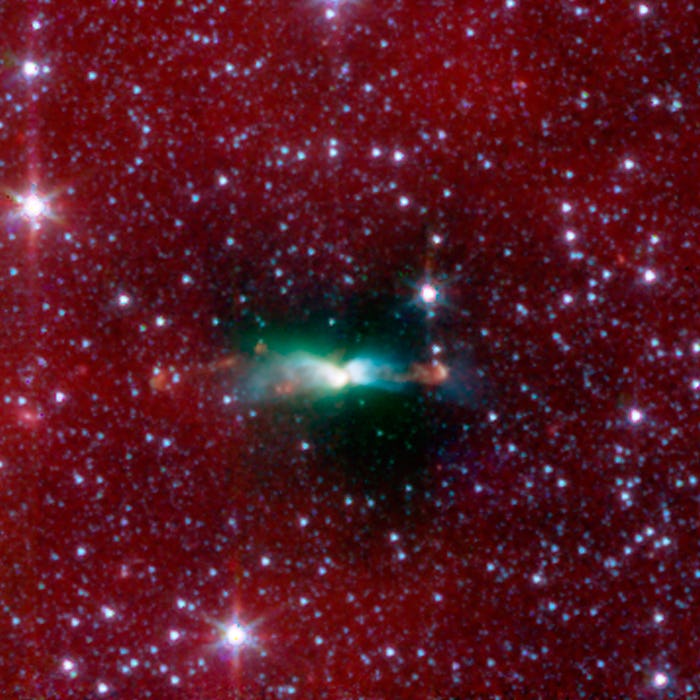
The universe is just wild. It feels like every time astronomers think they know something — like, they really think they know what they are looking at — along comes a baby star hidden in a veil of cosmic dust to confound expectations.
OK, so maybe that exact scenario doesn't happen every time a new finding defies old knowledge about the universe, but it did happen in the case of L843.
This is an adapted version of the Inverse Daily newsletter for Wednesday, June 215, 2022. Subscribe for free and learn something new every day.
You can read about that discovery and more in today’s Inverse Daily. As a special treat, I’ve selected a wonderful story by our entertainment writer, Dais Johnston, about their time covering the Star Wars Celebration and the new fandom around the much-maligned Star Wars prequel films. I hope you enjoy it!

Europe’s space agency greenlights Comet Interceptor to study the next ’Oumuamua
This week, the European Space Agency greenlit a scheme to park a comet-intercepting spacecraft at the second LaGrange point, or L2.
Called the Comet Interceptor, the craft will launch in 2029 and then hang out with the Webb until an as-yet-undiscovered comet happens to fly into its sphere — then, it will do what the name suggests: Intercept the comet. If successful, Comet Interceptor will shed light on the formation of our Solar System, the interstellar medium, and may even help answer an issue closer to home: How to prevent a comet from hitting Earth.
The Comet Interceptor mission will be the first to (hopefully) visit and study a long-period comet, and preferably, one in “pristine” condition. This kind of comet is one that is on its first trip inward toward the Sun. A similarly attractive option would be a drifting interstellar object like ’Oumuamua, which astronomers discovered in 2017 and is on its way out of our Solar System.
While most astronomers agreed that ’Oumuamua was probably the remains of a disintegrating comet or even a chunk of a dwarf exoplanet, a cadre of scientists led by Avi Loeb of Harvard University argue that it could be an alien spacecraft. Comet Interceptor could have settled the debate, but it’s too late for the Interceptor to check out ’Oumuamua — we’ll need to wait for another opportunity, instead.

Rogue star gatecrashes cosmic baby-making party
L843 had a secret. A protostar in a distant stellar nursery called the Aquila Rift, L843 had a twisted magnetic field, and researchers weren’t sure why. Behind a veil of dust, astronomers found the culprit: a baby star locked in a gravitational embrace with the protostar, hidden in a cosmic nest.
The discovery will help astronomers find more star pairs like this by searching for peculiarly-shaped magnetic fields, which can act as a beacon toward baby stars. The discovery also provides hints on how binary systems come to exist. That’s a big part of understanding the universe, because half of all Sun-like stars in space come in twos.
Binary stars are “notoriously difficult to observe at their youngest stages in life,” Astronomer Erin Guilfoil Cox at Northwestern University tells Inverse. “That’s because they’re enshrouded in this gas and dust, and so they are pretty invisible to most telescopes. We don’t know much about their very earliest stages of life.”
Guilfoil Cox led the team that peered into L483, the cloud at the heart of the study. Cox and colleagues turned to several observatories including the airplane-based Stratospheric Observatory for Infrared Astronomy (SOFIA), the Atacama Large Millimeter Array (ALMA) Radio Telescope in Chile, and the Pico dos Dias Observatory in Brazil.
A paper published Tuesday in The Astrophysical Journal details the findings.

At Star Wars Celebration, the prequels have become the main event
If Star Wars is a Christian allegory, then the Star Wars Celebration was the nativity, writes our reporter Dais Johnston. Dais attended the Celebration for Inverse — here’s what they found:
“At the midpoint of Star Wars Celebration, a four-day conference devoted to that galaxy far, far away, attendees gather for a panel devoted to the 20-year anniversary of Episode II: Attack of the Clones. But before the cast and crew can take the stage, fans clamber onto the platform for a pre-show “pose-off.”
They pose as “a youngling after Order 66,” “Jango Fett,” and even a pair who described their poses as “You were my brother, Anakin!” and “I HATE YOU!” from the duel on Mustafar in Episode III: Revenge of the Sith.
Then, a man and woman take the stage. He falls to his knees with a shirt draped over his head. Opposite him, she lies on her back, eyes closed, one hand held to her pregnant stomach.
The crowd holds its breath as the emcee places a microphone on the man’s hidden face. He announces his pose as “Count Dooku.” Before the emcee can even make his way to the woman, the crowd grows wild. They know exactly who she is: Padmé Amidala.
Pregnant Padmé won the pose-off, and her victory may be bigger than just a pre-panel contest.
Star Wars Celebration was the latest sign of a major cultural shift. After years of being the ugly stepchild of the Skywalker Saga, the prequels have found their way to a nostalgic sweet spot.”

PEOPLE ISOLATED FROM SOCIETY HAVE DIVERGENT LEVELS OF CERTAIN BLOOD MOLECULES
Hikikomori stems from hikikomoru, a compound verb made up of the Japanese characters for “to pull back” and “to seclude oneself.” Extreme social withdrawal has been observed among Japanese youth since the 1970s and by the 1990s it was so common as to warrant its own descriptor. Today, it’s estimated that at least one million people in Japan experience extreme social withdrawal.
Hikikomori was first thought to be a Japanese-specific sociocultural event, but experts now acknowledge anyone anywhere can experience the features of hikikomori. It’s also becoming more common.
In a new study published in the journal Dialogues in Clinical Neuroscience, researchers at Kyushu University in Japan reveal a breakthrough: There are specific blood biomarkers linked to hikikomori. These biological signatures are strong enough that researchers could identify who experiences extreme social withdrawal and who does not from their blood. One day, these biomarkers may lead to novel and much-needed treatments.
Takahiro Kato is the study’s senior author and an associate professor at Kyushu University. He’s also a leading expert in the study of hikikomori and established the first, and currently only, research clinic which specifically focuses on hikikomori in the world. In the past, Kato has examined the biological basis of depression. He suspected he might also be able to identify biological factors linked to hikikomori.
Here’s what Kato and his team found.

About this newsletter: Do you think it can be improved? Have a story idea? Want to share a story about the time you met an astronaut? Send those thoughts and more to newsletter@inverse.com.
- On this day in history: On June 15, 1215, the Magna Carta was sealed by the then king of England, John. The Magna Carta was essentially a bill of rights. At the time, it was aimed at avoiding civil war, but it became the basis for English jurisprudence.
- Song of the day: “Isle of Skye,” by Magna Carta.







